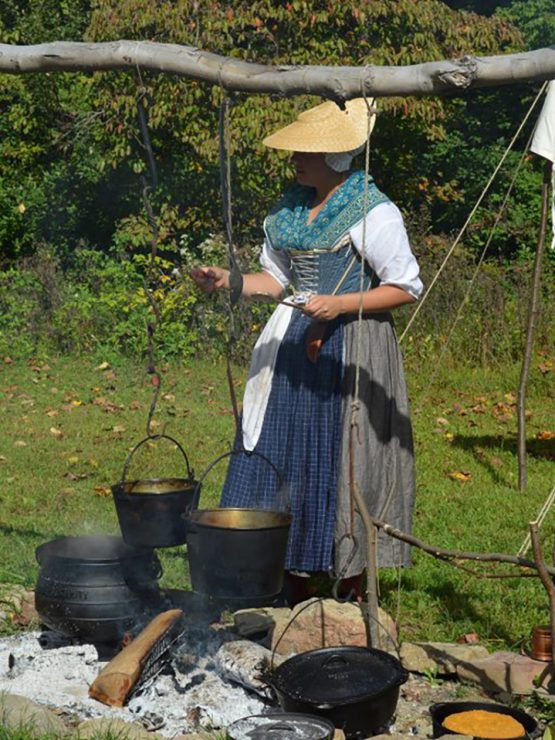Meadowcroft Rockshelter and Historic Village invites learners to get out of the classroom and experience history in action. Through its three recreated villages representing the 16th, 18th, and 19th centuries, as well as the Meadowcroft Rockshelter archaeological site, Meadowcroft allows visitors of all ages to explore the lives of humans living in the region throughout the centuries.
 Sarah Kizina works as an interpreter at Meadowcroft, where she appreciates the chance to help visitors experience history outside of the traditional classroom setting. Interpreters like Kizina help history come to life, allowing for a deeper understanding of history through first-person perspectives.
Sarah Kizina works as an interpreter at Meadowcroft, where she appreciates the chance to help visitors experience history outside of the traditional classroom setting. Interpreters like Kizina help history come to life, allowing for a deeper understanding of history through first-person perspectives.
We caught up with Kizina during the off-season to find out more about her experiences at Meadowcroft.
1. How did you first get involved at Meadowcroft?
My first season working at Meadowcroft was in 2013. I had graduated with my master’s in Museum Studies and, having moved back to the Pittsburgh area with my husband, began looking for museum work. My father-in-law shared an ad he saw in the paper. Having remembered visiting Meadowcroft as a kid, I applied thinking it would be a fun place to work– and it is!
2. What is your role?
I am an Interpreter/Tour Guide. Sometimes there is confusion with the title as people expect you to be fluent in a foreign language. Meadowcroft Interpreters take historical information presented to us by the education department and we “interpret” that information to guests (in English, although there are staff members who can speak other languages).
3. What do you enjoy most about it?
I love that I get to educate in a fun way. The informal setting allows people to approach history in Western Pennsylvania in a way in which they can be comfortable. Sometimes people are most comfortable simply listening and observing conversations I’m having with other guests. Others get fully involved: actively asking questions, picking up our touchable collection, and even getting their hands dirty when we have hands-on activities.
Learning by doing gives you an insight into the past that is more personal and helps you gain a better understanding of the “why” we ask when studying history. It’s learning that really sticks with people, and it’s what I hear most from return visitors – “Can you still throw the Atlatl?” or “I remember visiting in elementary school and dipping a candle!”
4. What kind of research and preparation goes into being an interpreter?
We are provided with educational material for all of the villages and the Rockshelter. As we gain interest in certain areas, we are encouraged to borrow books from the onsite education library. While at Meadowcroft, I honed in on my interests of gardening, cooking, and America’s gastronomic history. I researched 19th-century gardening and agriculture while redesigning the Miller Log House’s kitchen garden. From that, I began examining how food was prepared and preserved, which led to more research and eventually organizing open-hearth cooking demonstrations these past two seasons. Food is so approachable to people and it’s a great way to look at American history.
Preparing for a demonstration, however, is hard work. I need to make sure what I’m cooking is both in season and available for the time period I’m representing (I’ve cooked both in the 19th-century Hamilton Log House and in the 18th-century Frontier Trading Post). Researching the menu, ingredients, and process are all necessary. Then I need to shop, gather all the tools and props I need for the cooking demo, set up my demo area, perform the demonstration, clean up, and put everything back in its place. It usually takes a few days for the whole process, not including the research, which can take weeks. In the end, it’s all worth it!
5. What’s one of the most interesting things you’ve learned through your role?
Susan B. Anthony, like the boss that she was, highjacked the national July 4th celebration in 1876 to present a copy of “Declaration of Rights of the Women of the United States” to Senator Thomas Ferry in Philadelphia (who was there on President Grant’s behalf). She then moved to a platform and read the speech. I had the opportunity during one of our Independence Day Celebrations to recite the speech, which proved both exhilarating and humbling.
Want to learn more? Check out these posts written by Kizina on Frank Frances’ photographs of baseball players and open hearth cooking for the Discover Meadowcroft blog, as well as this article on Andy Warhol for the Pittsburgh Post-Gazette.
Kim Roberts is the communications coordinator at the History Center.



